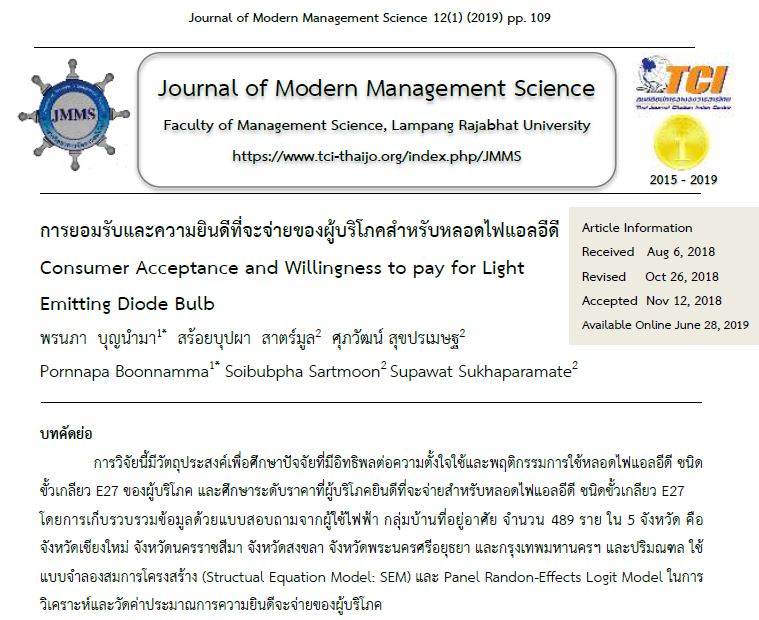Consumer Acceptance and Willingness to pay for Light Emitting Diode Bulb
Main Article Content
Abstract
The purposes of this research were to study the factors affecting consumers’ intention and usage behavior of Light Emitting Diode (LED) bulbs; and to determine consumers’ willing to pay for LED bulbs in Thailand. Conceptual framework was applied from Technology Acceptance Model (TAM) and Contingent Valuation Method (CVM) using double bounded closed-ended questions.
Data were observed using self-reported questionnaires from 489 residential electric lighting users in five provinces of Thailand; Chiangmai, Nakhon Ratchasima, Phra Nakhon Si Ayutthaya, Songkhla, and Bangkok. Methods of study applied to Quantitative research using Structural Equation Modeling (SEM) and Panel Randon-Effects Logit Model. The results of this study found that the respondents were willing to pay an additional cost of 37.16 Baht for energy saving of LED and 15.94 Baht for the longer lifetime of LED bulbs, and attitude toward LED bulb and subjective norms positive affected consumers’ intention and usage behavior of LED bulbs. These findings implied that if the government would like to encourage people to switch to use LED bulbs, they should emphasize more on energy saving aspect than the longer lifetime of LED bulb since users paid more attention to energy saving.
Article Details
The article must be considered and accepted for publication by the editorial board of the Faculty of Management Science, Lampang Rajabhat University. The articles have been reviewed by a peer (peer review) and the author must update according to the suggestion if available before publication. Articles that are not considered the editorial team will inform the results of the consideration but will not send the original to the author.
JMMS is the Faculty of Management Science journal, Lampang Rajabhat University. Jmms published both print and online editions. We allow the use of articles for academic use under the scope of copyright law.
References
th.pdf, 15 พฤษภาคม 2561.
การไฟฟ้าฝ่ายผลิตแห่งประเทศไทย. (2560). กราฟและสถิติ. เข้าถึงได้จาก: https://www.egat.co.th/index.php?option=com_content&view=article&id=76&Itemid=116,
15 พฤษภาคม 2560.
การไฟฟ้าฝ่ายผลิตแห่งประเทศไทย. (2557). 20 ปีการจัดการด้านการใช้ไฟฟ้า.
เข้าถึงได้จาก: https://e-saving.egat.co.th/20DSM/20DSM-news.html, 28 พฤศจิกายน 2557.
การไฟฟ้าฝ่ายผลิตแห่งประเทศไทย. (2557). Demand Side Management (DSM).
เข้าถึงได้จาก: https://www.dsm.egat.co.th, 28 พฤศจิกายน 2557.
การไฟฟ้าฝ่ายผลิตแห่งประเทศไทย. (2557). World Market for Lamps by Technology.
เข้าถึงได้จาก: https://e-saving.egat.co.th/LED/led2.html, 30 กันยายน 2557.
นริศรา คุ้มรักษา. (2558). การศึกษาความพึงพอใจของผู้ใช้หลอดไฟ LED ในเขตกรุงเทพมหานครและปริมณฑล.
การค้นคว้าอิสระปริญญามหาบัณฑิต. คณะพาณิชยศาสตร์และการบัญชี มหาวิทยาลัยธรรมศาสตร์, กรุงเทพมหานคร.
ภัทราวดี วงค์สมุทร. (2556). ปัจจัยที่มีอิทธิพลต่อการยอมรับและการใช้งานระบบการเรียนผ่านเว็บ.
วารสารนักบริหาร, 33 (3), 3-10.
Ajzen, I. (1985). From Intention to Actions: A Theory of Planned Behavior. In: Kuhl, J. and Beckmann, J. (Eds.), Action Control: From Cognition to Behvior, Berlin: Springer-Verlag.
Ajzen, I. (1991). The Theory of Planned Behavior, Organizational Behavior and Human Decision
Processes, 50(2), pp. 179-211.
Davis, F. D. (1989). Perceived Usefulness , Perceived Ease of Use, and User Acceptance
of Information Technology, MIS Quarterly, 13(3), 319-339.
Ervasti, M. & Helaakoski, H. (2010). Case Study of Application‐based Mobile Service Acceptance and Development in Finland. Int. J. Information Technology and Management, 9 (3), 243-259.
Fishbein, M. & Ajzen, I. (1975). Belief, Attitude, Intention and Behavior: An Introduction
to Theory of Research, Addison-Wesly, Reading MA.
IEA. (2010). Phase out of Incandescent Lamps. Implications for International Supply and
Demand for Regulatory Compliant Lamps. Information Paper. OECD/IEA, Paris.
Karl G. J. (1999). How Large Can a Standardized Coefficient be?. Retrieve Form
https://www.ssicentral.com/lisrel/techdocs/HowLargeCanaStandardizedCoefficientbe.pdf
Lai P. C. & Zainal A. A., (2015). Consumers’ Intention to Use a Single Platform E-Payment System: A Study among Malaysian Internet and Mobile Banking Users. Journal of Internet Banking and Commerce, 20(1), pp. 1-13.
Orose Leelakulthanit. (2014). The Factors Affecting The Adoption of LED Lamps. International Business and Economics Research, 13(4), pp. 754-767.
Roger, E. M. (1995). Diffusion of Innovation. Now York: The Free Press.


